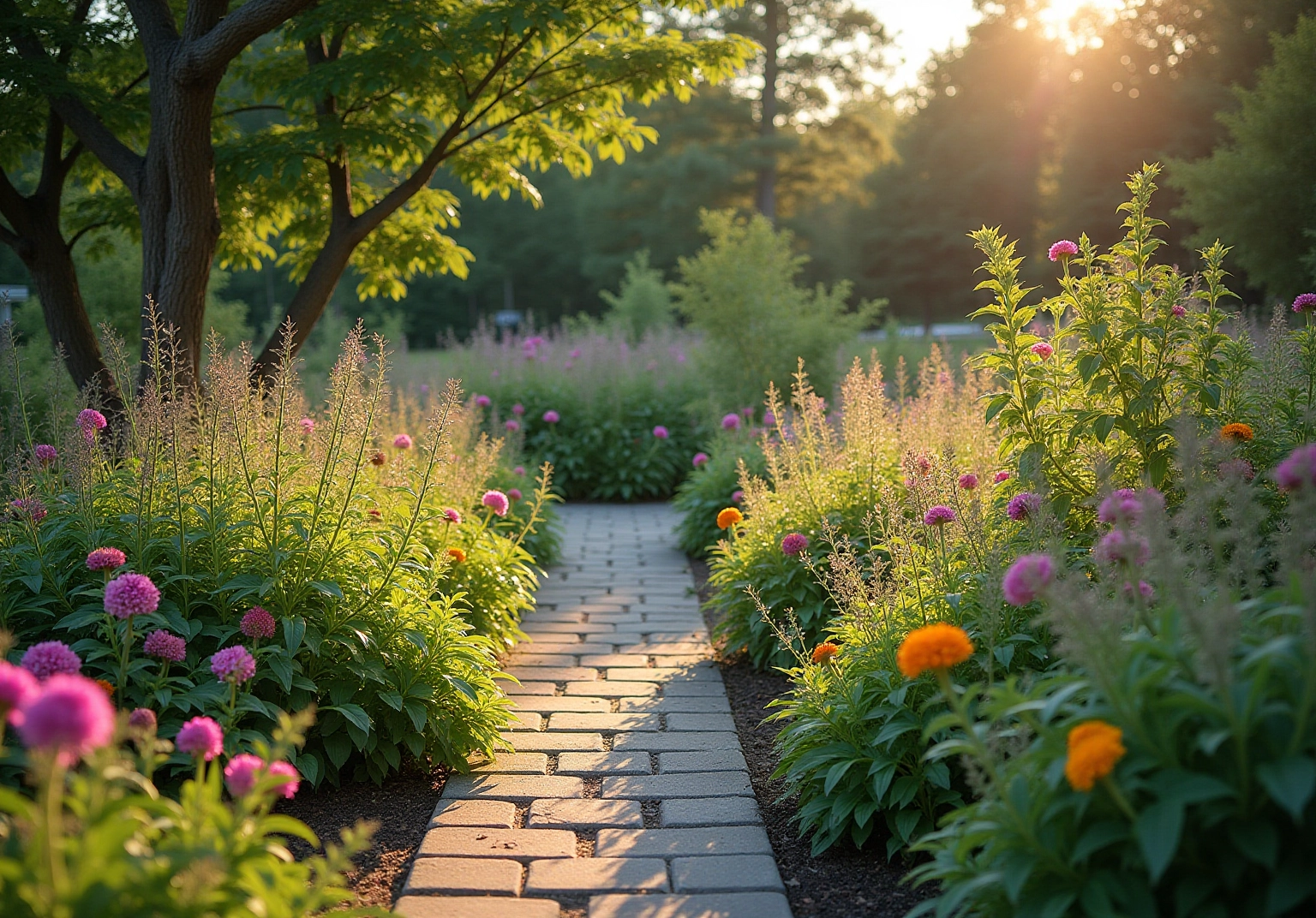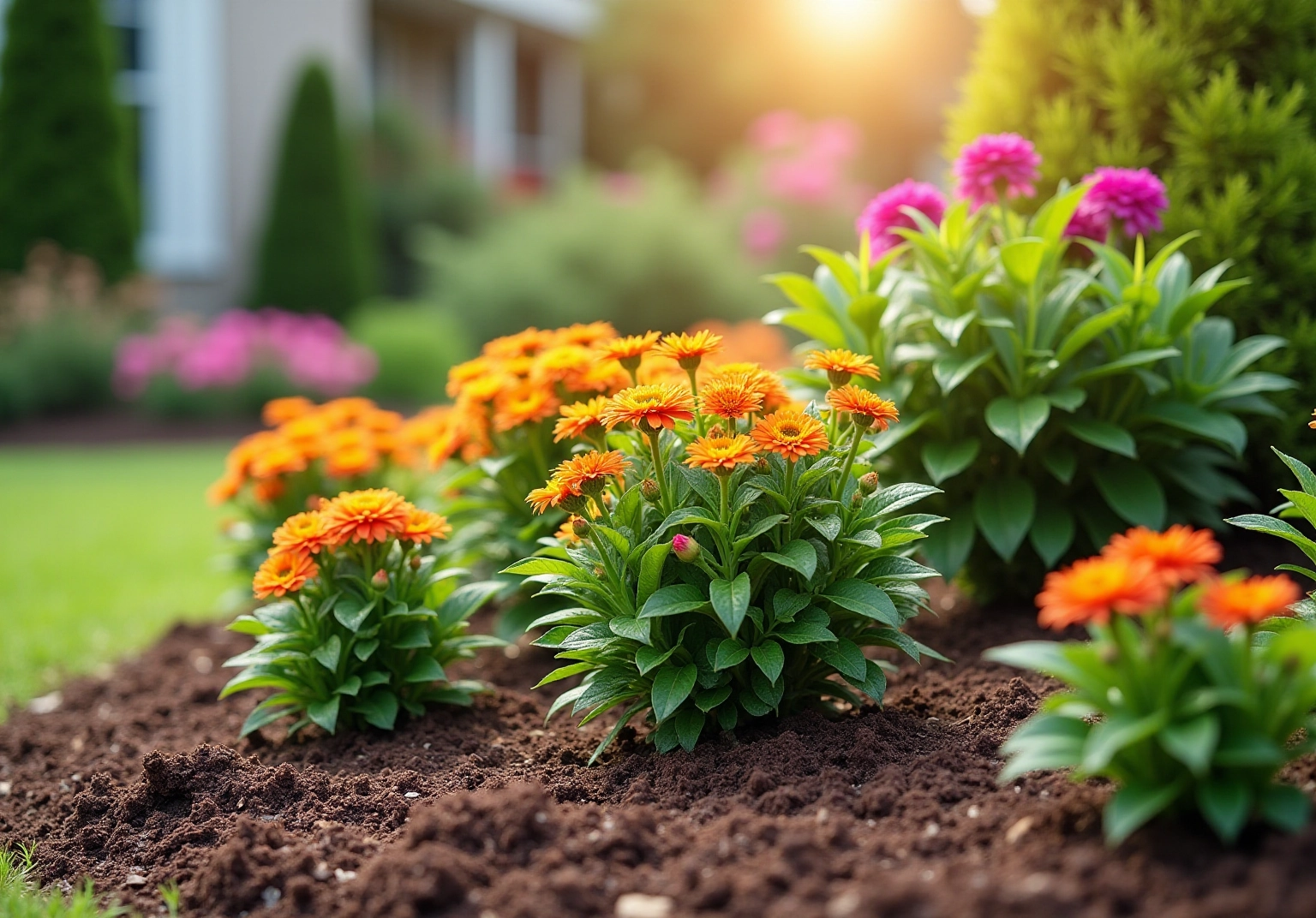Overview
The article emphasizes the mastery of flower and landscape design to create luxurious outdoor spaces, focusing on principles such as balance, unity, and proper plant selection. By detailing essential design elements and maintenance practices, it highlights how these features enhance both aesthetic appeal and functionality. This transformation of outdoor areas into inviting retreats not only reflects personal style but also significantly improves property value.
How do you envision your outdoor space? With the right design approach, your garden can become a beautiful extension of your home, tailored to your lifestyle and preferences.
Introduction
Creating a luxurious outdoor space transcends mere flower planting; it’s an art form that harmonizes aesthetics with functionality, enhancing any property. As homeowners increasingly recognize the significant impact of thoughtfully designed landscapes on curb appeal and property value, grasping the fundamental principles of flower and landscape design becomes vital.
How can one elevate a mundane yard into a stunning retreat that mirrors personal style and flourishes through the seasons? This article explores essential strategies and practices that not only amplify beauty but also ensure enduring vibrancy in outdoor environments.
Understand the Principles of Effective Flower and Landscape Design
Effective flower and landscape design is anchored in several fundamental principles that elevate both aesthetics and functionality:
- Balance: Achieving visual harmony is essential. This can be accomplished through symmetrical arrangements that evoke a sense of formality or asymmetrical compositions that create a more relaxed atmosphere. Such balance enhances beauty and contributes to the overall harmony of the space.
- Unity: All elements within the landscape should work cohesively. A unified design fosters a seamless flow in the outdoor environment, ensuring that features like flower and landscape elements complement one another rather than compete.
- Scale and Proportion: It is vital to select plants and features that are appropriately sized for the space. This principle enhances the overall aesthetic and ensures that each element feels integrated into the surroundings rather than overwhelming it.
- Focal Points: Incorporating areas of interest, such as a striking sculpture or a vibrant flower bed, draws the eye and creates intrigue. These focal points can serve as conversation starters, enhancing the overall appeal of the outdoor space.
- Rhythm and Repetition: Utilizing patterns and repeated elements fosters a sense of movement and flow throughout the environment. This rhythm can guide visitors through the space, creating an engaging experience that encourages exploration.
In 2025, the latest trends in outdoor aesthetics highlight the importance of balance and unity in flower and landscape design, particularly as homeowners increasingly recognize their impact on property value. Well-crafted layouts that incorporate flower and landscape, including expertly arranged planting beds and seasonal displays, can significantly enhance a property’s curb appeal, making it more appealing to potential buyers. Successful garden projects often highlight elements of flower and landscape, illustrating how careful planning can convert spaces into luxurious retreats that embody personal lifestyles and preferences.
At Grow Landscapes, our meticulously crafted 3D design renderings provide assurance in the process, enabling us to refine the specifics of your outdoor vision. As Scott McLeod, a designer with over 30 years of experience, states, “My focus is on creating beautiful and functional spaces that endure through time.” Integrating these principles not only improves aesthetic charm but also guarantees that the environment is both welcoming and functional.

Choose the Right Plants for Your Landscape Conditions
Choosing the appropriate greenery for your flower and landscape is essential for establishing a flourishing outdoor setting. Consider the following key factors to guide your choices:
-
Climate Compatibility: Selecting vegetation that is well-suited to the local climate of Northern Virginia is crucial. Take into account temperature ranges and rainfall patterns. Indigenous species are especially advantageous, as they thrive in regional conditions and require less water and upkeep. In fact, indigenous vegetation can decrease outdoor water consumption by as much as 70% compared to conventional lawns and non-indigenous gardens.
-
Soil Type: Understanding the soil’s texture, pH, and drainage capabilities is vital. Different species flourish in various types of soil, so conducting a soil examination can help identify the optimal choices for your garden. For instance, sandy soils drain rapidly, while clay soils retain moisture, significantly affecting vegetation selection.
-
Sunlight Exposure: Assess the sunlight each area of your landscape receives—whether it’s full sun, partial shade, or full shade. This assessment will assist you in choosing greenery that will thrive in their assigned locations, ensuring a vibrant and healthy garden.
-
Maintenance Requirements: Reflect on your ability to care for the selections you choose. Opt for varieties that align with your maintenance preferences, considering factors such as watering frequency, pruning needs, and susceptibility to pests and diseases. Drought-tolerant native species can significantly reduce upkeep while enhancing ecological balance.
-
Seasonal Interest: Incorporate a diverse mix of greenery that provides year-round visual appeal. Choose species with varying bloom times and foliage colors to create a dynamic setting that evolves with the seasons. Including plants that bloom at different times ensures continuous interest throughout the year.
By thoughtfully considering these factors, homeowners can cultivate a vibrant environment featuring both flower and landscape, which enhances their outdoor living experience and positively contributes to the local ecosystem.

Plan Your Landscape Layout for Optimal Aesthetics and Functionality
Planning your layout for flower and landscape involves several essential steps that contribute to both aesthetics and functionality.
-
Site Analysis: Begin by evaluating the existing conditions of your yard, including topography, drainage, and existing vegetation. This foundational step ensures that your design integrates flower and landscape features tailored to the unique characteristics of your space, enhancing its overall appeal and functionality.
-
Define Zones: Establish distinct areas for various activities—such as dining, relaxation, and gardening—to enhance usability. This zoning approach not only organizes the space but also promotes a harmonious flow between different functions, allowing for a more enjoyable outdoor experience.
-
Flow and Accessibility: Design pathways and access points that promote movement throughout the area. Ensuring ease of use is crucial for creating an inviting outdoor environment, making it more accessible for family and guests alike.
-
Visual Lines: Employ lines and shapes to direct the eye through the scenery, creating depth and visual interest. Thoughtful placement of elements can enhance the overall aesthetic appeal, drawing attention to the beauty of your flower and landscape.
-
Incorporate Hardscaping: Integrate hardscape features like patios, walkways, and retaining walls to provide structure and enhance usability. These elements enhance the natural scenery while providing practical advantages, ultimately increasing the value of your property.
By following these planning principles, homeowners can create an outdoor environment that features a stunning flower and landscape design while also being functional and perfectly aligned with their lifestyle needs. Imagine how these enhancements can transform your outdoor space into a luxurious retreat.

Implement Maintenance Practices for Long-Lasting Beauty
To maintain the beauty of your landscape, consider the following practices:
-
Regular Pruning: Regular pruning involves trimming greenery to encourage healthy growth and maintain desired shapes. This practice not only prevents overcrowding but also enhances the overall aesthetic of your outdoor space through thoughtful flower and landscape design.
-
Mulching: Applying mulch is essential for retaining moisture, suppressing weeds, and enhancing soil health. This simple step can significantly improve the vitality of your plants and reduce maintenance efforts.
-
Fertilization: Utilizing suitable fertilizers tailored to the specific requirements of your greenery supplies vital nutrients. This targeted approach ensures that your plants thrive, contributing to a lush and vibrant flower and landscape.
-
Weed Control: Effective weed management strategies are crucial in preventing competition for resources. By controlling weeds, you allow your plants to flourish without unnecessary stress.
-
Seasonal Clean-Up: Performing seasonal maintenance tasks, such as removing debris and dead plant material, keeps the area tidy and healthy. This practice not only enhances the visual appeal of your flower and landscape but also promotes a thriving environment.
By adopting these maintenance practices, homeowners can ensure their flower and landscape features remain vibrant and inviting for years to come. Have you considered how these simple steps could transform your outdoor space into a luxurious retreat?

Conclusion
Mastering flower and landscape design is essential for creating luxurious outdoor spaces that are both beautiful and functional. By understanding and applying the fundamental principles of design, homeowners can transform their gardens into stunning retreats that reflect their personal style while enhancing property value.
Key insights from this article emphasize the importance of:
- Balance
- Unity
- Scale in landscape design
Choosing the right plants based on local climate, soil type, and sunlight exposure is crucial to establishing a thriving environment. Additionally, careful planning of the landscape layout—considering flow, accessibility, and hardscaping—ensures that outdoor spaces are not only visually appealing but also practical for various activities. Regular maintenance practices further contribute to the longevity and vibrancy of these outdoor havens.
Ultimately, investing time and effort into flower and landscape design can yield remarkable results, turning ordinary gardens into extraordinary spaces. Embracing these best practices not only enhances the beauty of outdoor areas but also fosters a deeper connection with nature, providing a serene escape from the everyday hustle. The journey to a luxurious outdoor space begins with these foundational principles—take the first step today and unlock the full potential of your garden.
Frequently Asked Questions
What are the fundamental principles of effective flower and landscape design?
The fundamental principles include balance, unity, scale and proportion, focal points, and rhythm and repetition.
How does balance contribute to flower and landscape design?
Balance achieves visual harmony, which can be accomplished through symmetrical arrangements for formality or asymmetrical compositions for a relaxed atmosphere, enhancing the overall beauty and harmony of the space.
What is the importance of unity in landscape design?
Unity ensures that all elements within the landscape work cohesively, fostering a seamless flow and allowing features to complement each other rather than compete.
Why are scale and proportion important in landscape design?
Selecting appropriately sized plants and features enhances the overall aesthetic and ensures that each element feels integrated into the surroundings without overwhelming the space.
What role do focal points play in landscape design?
Focal points, such as striking sculptures or vibrant flower beds, draw the eye and create intrigue, serving as conversation starters and enhancing the overall appeal of the outdoor space.
How do rhythm and repetition affect the design?
Rhythm and repetition create patterns that foster a sense of movement and flow throughout the environment, guiding visitors and encouraging exploration.
What trends are emerging in outdoor aesthetics for 2025?
Trends highlight the importance of balance and unity in flower and landscape design, as homeowners recognize their impact on property value and curb appeal.
How can well-crafted layouts enhance a property’s appeal?
Expertly arranged planting beds and seasonal displays can significantly enhance a property’s curb appeal, making it more attractive to potential buyers.
What services does Grow Landscapes provide?
Grow Landscapes offers meticulously crafted 3D design renderings to help refine outdoor visions, ensuring beautiful and functional spaces.
What is the philosophy of designer Scott McLeod regarding landscape design?
Scott McLeod focuses on creating beautiful and functional spaces that endure over time, integrating design principles to improve both aesthetic charm and functionality.



